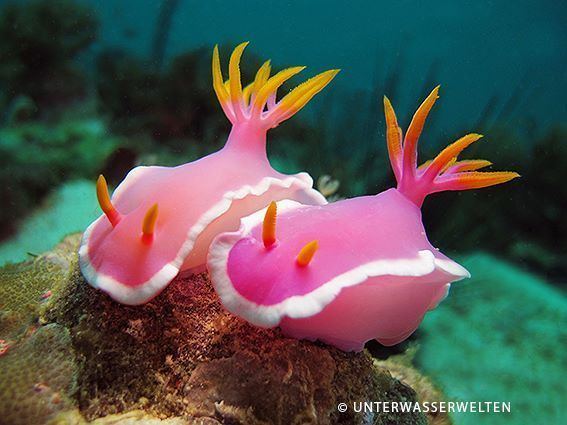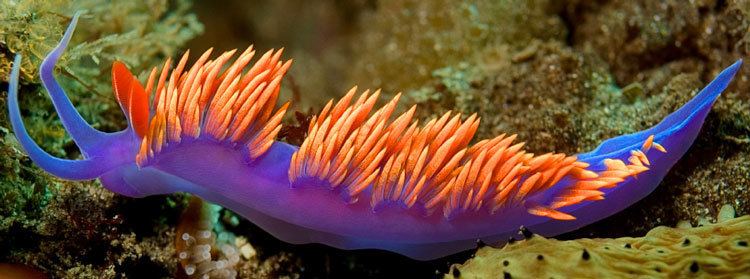 | ||
Representative species Hypselodoris festiva, Blue glaucus, Chromodoris lochi, Melibe viridis, Spanish dancer | ||
Sea slugs are like real life pokemon feat animal wire
Sea slug is a common name for some marine invertebrates that more or less resemble terrestrial slugs. Most creatures known as sea slugs are actually snails, i.e. they are sea snails (marine gastropod mollusks) that over evolutionary time have lost their shells, or have a greatly reduced shell or an internal shell. The name "sea slug" is most often applied to nudibranchs, as well as to a paraphyletic set of other marine gastropods without obvious shells.
Contents
- Sea slugs are like real life pokemon feat animal wire
- Mucky secrets part 19 sea slugs feeding mating lembeh strait
- Shell less marine gastropods
- Gastropod groups
- Non molluscan uses of the name
- References

The phrase "sea slug" is, however, also sometimes applied to taxa in other phyla, such as the sea cucumbers, which are not mollusks but echinoderms. Although the other animals sometimes called "sea slugs" are not gastropods, they are nonetheless soft-bodied, and their overall shape is slug-like.

True sea slugs have enormous variation in body shape, color, and size. Most are partially translucent. The often bright colors of reef-dwelling species implies that these are under constant threat of predators, but the color serves as a warning to other animals of the sea slug's poisonous stinging cells. Like all gastropods, they have small razor-sharp teeth, called radulas. Most sea slugs have two pairs of tentacles on their head used primarily for sense of smell, with a small eye at the base of each tentacle. Many have feathery structures (ceratia) on the back, often in a contrasting color, which act as gills. All species of genuine sea slugs have a selected prey animal on which they specialize for food, including certain jellyfish, bryozoans, sea anemones, and plankton as well as other species of sea slugs.

Mucky secrets part 19 sea slugs feeding mating lembeh strait
Shell-less marine gastropods

The name "sea slug" is often applied to numerous different evolutionary lineages of marine gastropod molluscs or sea snails, specifically those gastropods that are either not conchiferous (shell-bearing) or appear not to be. In evolutionary terms, losing the shell altogether, having a small internal shell, or having a shell so small that the soft parts of the animal cannot retract into it, are all features that have evolved many times independently within the class Gastropoda, on land and in the sea; these features often cause a gastropod to end up labeled with the common name "slug".

Nudibranchs (clade Nudibranchia) are a large group of marine gastropods which have no shell at all. These may be the most familiar sort of sea slug, at least to scuba divers; nudibranchs, although most are not large, are often very eye-catching because so many of species have brilliant coloration. In addition to nudibranchs, a number of other taxa of marine gastropods (some easily mistaken for nudibranchs) are also often called "sea slugs".
Gastropod groups

Within the various groups of gastropods that are called "sea slugs" numerous families are within the informal taxonomic group Opisthobranchia:
The phrase "sea slug" is perhaps most often applied to nudibranchs, many of which are very colorful and are a noticeable part of the underwater fauna. For two examples see the images of Nembrotha aurea and Glossodoris atromarginata within this article.The name "sea slug" is also often applied to the sacoglossans (clade Sacoglossa), the so-called sap-sucking or solar-powered sea slugs; these are frequently some shade of green.Another group of main gastropods that are often labeled as "sea slugs" are the various families of headshield slugs and bubble snails within the clade Cephalaspidea; some of these are very brightly colored.The sea hares, clade Aplysiomorpha, are often quite large animals; they have a small, flat, proteinaceous internal shell. Sea hares are sometimes described as large sea slugs.The clades Thecosomata and Gymnosomata are small pelagic gastropods known as "sea butterflies" and "sea angels"; these are usually simply known as "pteropods" but can also loosely be called sea slugs, especially the Gymnosomata, which have no shell as adults.There is also one group of "sea slugs" within the informal group Pulmonata:
One very unusual group of marine gastropods that are shell-less are the pulmonate (air-breathing) species in the family Onchidiidae, within the clade Systellommatophora.Lettuce Sea Slug, looks like a piece of lettuce. It has ruffles that help maximize the absorption of sunlight because it increases its surface area. Pyjama Sea Slug, their bright patterns are used to defend against predators by warning them. Usually, predators don’t go for this organism because of the chemicals that are secreted if attacked. Blue Sea Slug, this brave sea slug feeds on one of the ocean’s most feared organisms, the Portuguese Man-of-War. The Blue Sea Slug is immune to its stinging cells and stores all its toxins in its own feather-like “fingers” to use them as its own defense.
Non-molluscan uses of the name
Sea cucumbers are also sometimes referred to as "sea slugs" because of their appearance, although they are echinoderms.
This name has also been attributed to other taxa of marine invertebrates with morphology similar to the sea cucumbers, and has also been applied to some Anthozoa coral cnidarians, such as the order of the species Fungia.
